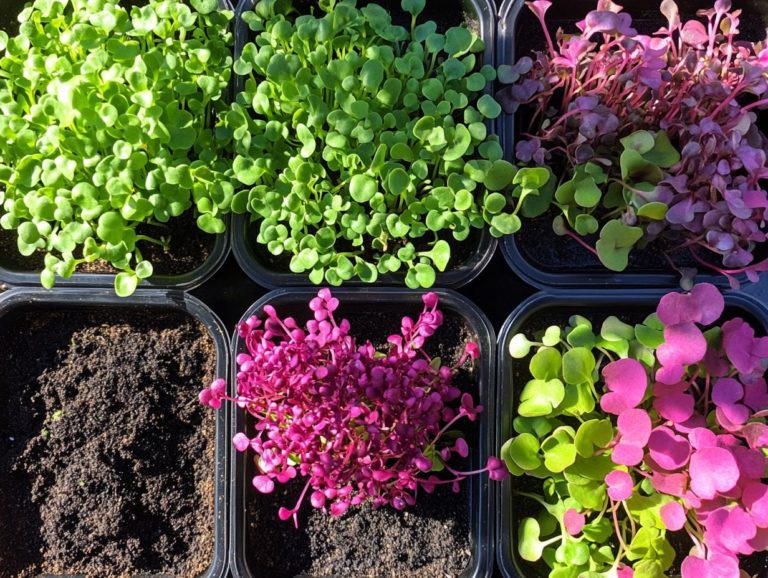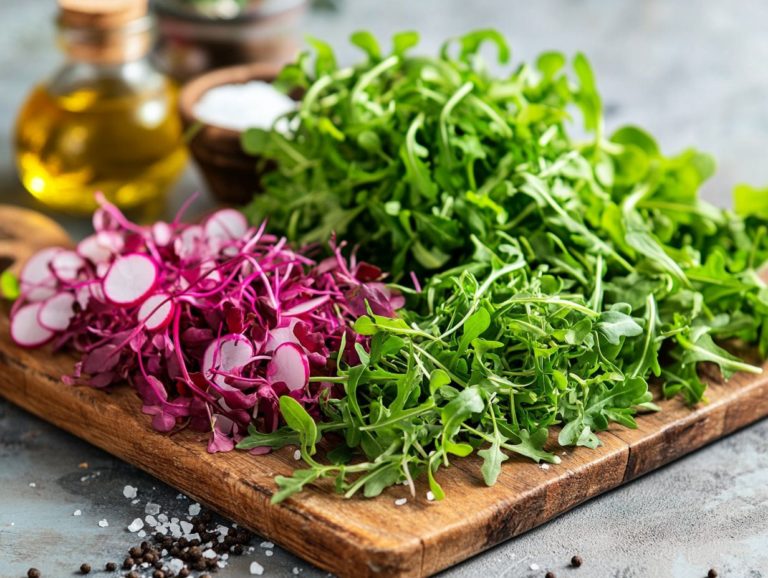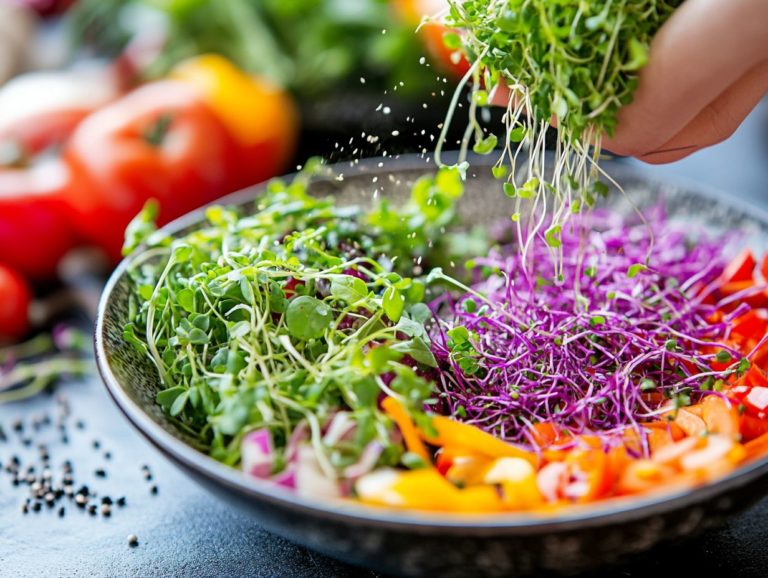The Influence of Microgreens on Overall Nutrition
Microgreens are tiny, flavorful plants bursting with nutrients. Don’t miss out on these nutrient-packed powerhouses! They make an exceptional addition to your diet.
This article delves into the remarkable health benefits of these little greens, comparing their nutritional profiles to mature vegetables. We’ll showcase their impressive antioxidant content.
You ll discover innovative ways to incorporate microgreens into your meals. We’ll also provide straightforward methods for growing them at home and tips for selecting the best varieties.
We ll even explore potential risks to ensure you enjoy them safely, discussing microgreens safety. Jump in and transform your meals!
Contents
- Key Takeaways:
- Nutritional Benefits of Microgreens
- Incorporating Microgreens into Your Diet
- Growing Your Own Microgreens
- Choosing the Right Microgreens
- Potential Risks and Precautions
- Frequently Asked Questions
- What are microgreens and how do they influence overall nutrition?
- What specific nutrients are found in microgreens?
- How do microgreens compare to their mature counterparts in terms of nutrition?
- Can microgreens help with weight loss and weight management?
- What are the health benefits of microgreens?
- How can I add microgreens to my meals?
Key Takeaways:

- Microgreens are a rich source of nutrients and antioxidants, making them a valuable addition to any diet.
- Adding microgreens to meals is an easy and delicious way to increase overall nutrition and add variety to your diet.
- Growing your own microgreens is a simple and cost-effective method to ensure freshness and quality, with a variety of flavors to choose from.
What are Microgreens?
Microgreens are young, edible plants harvested just after their first leaves emerge. They are loved for their great taste and health perks.
These tiny greens pack a powerful punch, offering concentrated sources of essential nutrients like vitamins and minerals. They make an ideal addition to your health-conscious diet.
Whether you re new to gardening or a culinary aficionado, growing your own microgreens can be a fun project. This grants you great health benefits that support your overall well-being.
With a plethora of microgreen varieties available, each boasting unique tastes and beneficial compounds, you can easily find the perfect fit for your palate. For instance, radish microgreens bring a zesty, peppery kick, while pea microgreens offer a sweet, fresh burst of flavor.
The growing process is refreshingly simple, requiring minimal space and resources. It s accessible for anyone with a sunny windowsill.
Microgreens are usually grown in soil or hydroponically, maturing in just a few days to a couple of weeks. This allows for rapid harvest cycles.
They not only elevate the flavors of your dishes but also contribute to a balanced diet rich in antioxidants and nutrients such as vitamins A, C, and K.
Incorporating microgreens like radish and pea microgreens into your meals can enhance salads, sandwiches, and smoothies, providing a delightful and health-promoting boost, rich in vitamins and fiber.
Nutritional Benefits of Microgreens
Microgreens aren’t merely a feast for the eyes; they are nutritional powerhouses brimming with essential vitamins and minerals, such as vitamin C and vitamin E. They make a remarkable addition to your healthy diet.
Their high nutrient density means that even a modest serving can deliver an impressive array of health benefits, such as enhanced immune function and the potential to combat diseases like cancer and heart disease.
High Nutrient Content and Antioxidants
The nutrient content of microgreens is truly remarkable, often surpassing that of their fully grown counterparts. This is why they ve earned the title of superfood.
These tiny greens are rich in antioxidants, vitamins like vitamin K, and dietary fiber. They make effective allies against oxidative stress and can help buffer against chronic diseases such as heart disease and cancer.
Packed with essential nutrients like vitamin C to boost your immune system and various B vitamins to support energy metabolism, these small powerhouses offer significant benefits. They also provide important minerals like calcium and potassium, enhancing bone health and cardiovascular function.
Moreover, the phytonutrients found in microgreens boast anti-inflammatory properties that can promote cellular health.
Incorporating microgreens into your diet could be a delightful way to elevate your nutrient intake while actively cultivating a healthier lifestyle. For those interested in specific options, exploring the top microgreen varieties for health enthusiasts enhances aspects like nutrition and overall well-being.
Comparison to Mature Greens
When you compare microgreens to mature greens, microgreens have striking nutritional advantages over mature greens. Their nutrients packed in is particularly impressive. While mature greens like kale and spinach certainly deliver essential nutrients, microgreens often provide a more concentrated dose of vitamins, minerals, and health benefits that are essential for fulfilling your dietary needs.
Research reveals that specific microgreen varieties, such as radish and broccoli, have significantly higher levels of vitamins C, E, and K compared to their fully-grown counterparts. Adding a handful of microgreens to your salads, smoothies, or sandwiches boosts your antioxidant intake while enjoying a burst of vibrant flavors. For more insights, discover why microgreens are superfoods you need.
The compact size and intense flavor of microgreens make them the perfect ingredient for enhancing dishes without overpowering other flavors. This allows both health and taste to shine in every meal, ensuring you savor every bite while nourishing your body. Exploring the role of microgreen varieties in plant-based diets can further elevate your culinary experience.
Incorporating Microgreens into Your Diet

Incorporating microgreens into your diet is a delightful and nutritious way to elevate your meals, infusing them with a burst of flavor and vibrant color often likened to ‘vegetable confetti.’ These tiny powerhouses transform salads and sandwiches into something special. They can seamlessly enhance any dish.
These fresh little powerhouses can enrich not just the taste but also your overall health with an abundance of nutrients.
Ways to Add Microgreens to Meals
There are countless versatile ways for you to incorporate microgreens into your meals, transforming them into a delightful and nutritious ingredient worth exploring, especially given their nutrient content and special nutrients.
Imagine giving your classic sandwich an exciting twist! These tiny greens can do it all. For a fresh twist, why not add them to your morning omelette or frittata? Their unique flavors blend well with eggs, creating a delicious start to your day.
You can also toss a handful of microgreens into your homemade pesto or pasta, giving your dishes not just a burst of color but an enriching layer of nutrition. Don’t hesitate to experiment with various pairings, like peppery arugula atop a creamy goat cheese crostini or sweet pea microgreens in a fruit salad. Don’t miss out on the delicious possibilities!
The possibilities are endless, allowing you to discover flavor combinations that elevate your everyday dishes into exciting culinary experiences.
Growing Your Own Microgreens
Cultivating your own microgreens is a straightforward and gratifying endeavor that any beginner gardener can appreciate. Not only do you reap health benefits, but you also experience the joy that comes from nurturing your own food.
You can easily grow these nutrient-rich greens at home with available growing kits, requiring minimal equipment and space. This makes the process accessible and enjoyable for everyone.
Simple and Cost-effective Methods
You have a wealth of simple and cost-effective methods at your fingertips for growing microgreens at home, making them an exceptional choice for anyone eager to enhance their nutritional intake. With readily available materials or specialized growing kits, you can effortlessly cultivate a diverse array of microgreens without needing extensive space or time.
Embarking on this rewarding journey is a breeze when you follow an easy step-by-step guide:
- First, decide on your growing medium be it soil, a hydroponic setup, or even a damp paper towel.
- Once you ve chosen your seeds arugula, basil, and radish are popular picks it s time to plant.
Scatter the seeds evenly over the medium, lightly covering them with your chosen medium, and ensuring they receive the right amount of moisture and light. As you monitor their growth over the following days, you’ll watch your greens thrive, encouraging you to fully embrace this sustainable practice and integrate microgreens into your daily meals.
Choosing the Right Microgreens
Selecting the perfect microgreens can elevate both flavors and health benefits. With a diverse range of options, you can make smart choices.
Varieties and Flavors to Try

Microgreens present an exquisite selection of varieties and flavors, each offering a distinctive taste and a wealth of health benefits that can elevate your cooking adventures. From the zesty kick of radish microgreens to the delightful sweetness of pea microgreens, there’s a perfect option to satisfy every palate.
Consider basil microgreens; they deliver a rich, aromatic flavor that mirrors their mature counterparts. They make a superb enhancement to pasta dishes and salads.
Broccoli microgreens are vibrant and provide an impressive nutritional boost, brimming with vitamins C and K. Exploring different microgreen varieties can transform your kitchen into a playground of flavors and textures.
Whether you sprinkle them over a savory omelet or blend them into a refreshing smoothie, these petite greens elevate any dish with a burst of freshness and nutrition that you’ll love!
Potential Risks and Precautions
While microgreens offer numerous health benefits, it’s vital to be aware of potential risks and precautions to enjoy their delicious benefits safely.
Considerations like food safety and possible allergy concerns can arise, making it imperative to handle and store microgreens with care.
Food Safety and Allergy Concerns
Food safety is crucial when enjoying microgreens, as improper handling and storage can pose health risks. You may have specific allergy concerns related to certain microgreen varieties, making awareness and caution essential.
When incorporating these nutrient-packed plants into your meals, adhere to thorough guidelines for safe handling practices. This involves:
- Wash your hands and surfaces before handling microgreens.
- Rinse the greens thoroughly under running water.
- Dry them with a clean cloth or paper towel to eliminate potential contaminants.
Storing microgreens in a clean, airtight container in the refrigerator can significantly enhance their freshness and quality. Be aware of possible allergies, as certain microgreens such as arugula and mustard greens may trigger reactions in sensitive individuals.
By educating yourself about these risks, you can savor microgreens safely while enjoying their vibrant flavors and remarkable health benefits.
Frequently Asked Questions
What are microgreens and how do they influence overall nutrition?
Microgreens are young vegetable greens harvested after only a few weeks of growth. They have a high concentration of nutrients, making them a great addition to a healthy diet.
What specific nutrients are found in microgreens?

Microgreens contain a variety of nutrients, including vitamins C, E, and K, as well as beta-carotene, lutein, and zeaxanthin. They are also high in antioxidants and minerals like potassium, iron, and zinc.
How do microgreens compare to their mature counterparts in terms of nutrition?
Studies show that microgreens can contain up to 40 times more nutrients than their mature counterparts, as they are harvested at a young age when nutrient levels peak.
Can microgreens help with weight loss and weight management?
Yes, microgreens can contribute to weight loss and weight management since they are low in calories but high in nutrients. They can also increase satiety and reduce cravings for unhealthy foods.
What are the health benefits of microgreens?
Microgreens are tiny edible plants that pack a nutritional punch. They can improve digestion, boost your immune system, and may lower your risk of serious diseases like heart disease and cancer.
How can I add microgreens to my meals?
It’s simple! Toss them into salads, add them to sandwiches, or blend them into smoothies.
You can even sprinkle them on pizza or pasta for an extra burst of flavor and color.






